In Unix and Unix-like operating systems, chmod is the command and system call used to change the access permissions and the special mode flags of file system objects. Collectively these were originally called its modes, and the name chmod was chosen as an abbreviation of change mode.

In computing, ls is a command to list computer files and directories in Unix and Unix-like operating systems. It is specified by POSIX and the Single UNIX Specification.

In computing, dir (directory) is a command in various computer operating systems used for computer file and directory listing. It is one of the basic commands to help navigate the file system. The command is usually implemented as an internal command in the command-line interpreter (shell). On some systems, a more graphical representation of the directory structure can be displayed using the tree command.
GNU Autoconf is a tool for producing configure scripts for building, installing, and packaging software on computer systems where a Bourne shell is available.

The GNU Autotools, also known as the GNU Build System, is a suite of programming tools designed to assist in making source code packages portable to many Unix-like systems.
In software development, Make is a build automation tool that automatically builds executable programs and libraries from source code by reading files called Makefiles which specify how to derive the target program. Though integrated development environments and language-specific compiler features can also be used to manage a build process, Make remains widely used, especially in Unix and Unix-like operating systems.
DICT is a dictionary network protocol created by the DICT Development Group in 1997, described by RFC 2229. Its goal is to surpass the Webster protocol to allow clients to access a variety of dictionaries via a uniform interface.

Nullsoft Scriptable Install System (NSIS) is a script-driven installer authoring tool for Microsoft Windows backed by Nullsoft, the creators of Winamp. NSIS is released under a combination of free software licenses, primarily the zlib license. It has become a widely used alternative to commercial proprietary products like InstallShield, with users including Amazon, Dropbox, Google, Ubisoft, FL Studio, BitTorrent, and McAfee.
An environment variable is a dynamic-named value that can affect the way running processes will behave on a computer. They are part of the environment in which a process runs. For example, a running process can query the value of the TEMP environment variable to discover a suitable location to store temporary files, or the HOME or USERPROFILE variable to find the directory structure owned by the user running the process.

Apache Ant is a software tool for automating software build processes which originated from the Apache Tomcat project in early 2000 as a replacement for the Make build tool of Unix. It is similar to Make, but is implemented using the Java language and requires the Java platform. Unlike Make, which uses the Makefile format, Ant uses XML to describe the code build process and its dependencies.

In computing, configuration files are files used to configure the parameters and initial settings for some computer programs. They are used for user applications, server processes and operating system settings.
CONFIG.SYS is the primary configuration file for the DOS and OS/2 operating systems. It is a special ASCII text file that contains user-accessible setup or configuration directives evaluated by the operating system's DOS BIOS during boot. CONFIG.SYS was introduced with DOS 2.0.
Files-11 is the file system used by Digital Equipment Corporation OpenVMS operating system, and also by the older RSX-11. It is a hierarchical file system, with support for access control lists, record-oriented I/O, remote network access, and file versioning.
AUTOEXEC.BAT is a system file that was originally on DOS-type operating systems. It is a plain-text batch file in the root directory of the boot device. The name of the file is an abbreviation of "automatic execution", which describes its function in automatically executing commands on system startup; the filename was coined in response to the 8.3 filename limitations of the FAT file system family.

The Windows Registry is a hierarchical database that stores low-level settings for the Microsoft Windows operating system and for applications that opt to use the registry. The kernel, device drivers, services, Security Accounts Manager, and user interfaces can all use the registry. The registry also allows access to counters for profiling system performance.

make menuconfig is one of five similar tools that can configure Linux source, a necessary early step needed to compile the source code. make menuconfig, with a menu-driven user interface, allows the user to choose the features of Linux that will be compiled. It is normally invoked using the command make menuconfig; menuconfig is a target in Linux Makefile.
A proxy auto-config (PAC) file defines how web browsers and other user agents can automatically choose the appropriate proxy server for fetching a given URL.
The FreeBSD Ports collection is a package management system for the FreeBSD operating system, providing an easy and consistent way of installing software packages. As of February 2020, there are over 38,487 ports available in the collection. It has also been adopted by NetBSD as the basis of its pkgsrc system.
In computing, a hidden folder or hidden file is a folder or file which filesystem utilities do not display by default when showing a directory listing. They are commonly used for storing user preferences or preserving the state of a utility and are frequently created implicitly by using various utilities. They are not a security mechanism because access is not restricted – usually the intent is simply to not "clutter" the display of the contents of a directory listing with files the user did not directly create.

A configure script is an executable script designed to aid in developing a program to be run on a wide number of different computers. It matches the libraries on the user's computer, with those required by the program before compiling it from its source code.






